 |
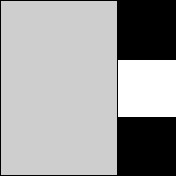 |
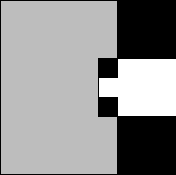 |
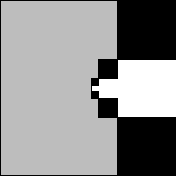 |
The Poly-dimensional Fields of Saxon-Szász
A creative artist between mathematics and the realm of “beautiful proportions”
When I first visited János Saxon-Szász, and his wife, Zsuzsa Dárdai,
whom I had basically considered as representatives of electrographics before,
it turned out at once that Jani Szász is not only a distinguished artist
of the innovative, experimental electrographic trend, but also a par excellence
painter. That is, his flat was filled with oil paintings, either ready or in
the making. Most paintings were almost monochrome, merely combining two colours,
the powerful tone of cadmium yellow and the flashy brightness of white. But
it was not this that I found most stunning; rather the fact that, although the
pictures were at first sight characterised by lucidly structured Constructivist
compositions following the established style of geometric abstraction, they
were not quite so! Behind the proportions that seemed so simple there lurked
an unusual complexity, and this tension, so difficult to unravel, proved almost
thrilling. And then, suddenly, it occurred to me what I was contemplating.—“Hey,
these are fractals!” I exclaimed. And so they were too, which was a sensation
not only because as an amateur scientist I had already been investigating this
fairly new branch of mathematics for some ten years, but also because as an
art historian I had never before found a successful application of fractal geometry
in the creative arts anywhere in the world.
Namely, the visual presentation, and beauty of fractal geometry had not emerged
from among creative artists. It was a gift of computer technology, and it astonished
the world as colour technology became widespread in the 1980s. The mathematics
behind fractals was also considered relatively novel, and initially it could
only interest a narrow circle of experts. But then the figures appearing on
the screen became unexpectedly colourful and rich. They conquered the most extreme
fields of visual culture overnight, so to speak, and they grew so popular that
for some time they even ousted Impressionist reproductions in exquisite bank
and company calendars. Many people bought computers merely to be able to display
on the screen or perhaps print out the overwhelmingly beautiful details of Mandelbrot's
set. And those who were more familiar with mathematics, could discover new fractal
algorithms and produce their “own” fractal geometric images.
But not even the virtuosi of digital technology and the craftsmen of visual
culture went further than that—fractal images never became “art,”
as the mathematical background for these interesting computer-generated figures
proved all too complicated and these images, heavily depending on computer technology,
remained the electronic “expressions” for certain mathematical calculations.
Meanwhile, the amateur enthusiasm surrounding fractals has subsided, and fractal
geometry (as well as chaos theory, the mathematical apparatus behind it) has
retreated to its more specialised fields and its results have been incorporated
into other branches of science. It is to Saxon-Szász's merit that as
a creative artist he found a way to handle fractals; his achievement is hardly
credible. Now that I wish to address his works more closely, I think it central
that I should—at least in a sketchy way—explain the real nature of
fractal geometry to the reader.
*
As a commonplace, we must start with the ancient Greeks. The origin of mathematics
is rooted in the spiritual and economic life of ancient societies; thus, geometry
was necessitated by territorial surveys (geometry itself means “land-measuring”),
Pythagoras' theorem being an arch-example, describing as it does the proportions
between the sides of a rectangle triangle. In all probability, ancient Greeks
took this knowledge from the Egyptians, who had to measure land patches anew
each year due to the floods of the Nile. In such circumstances, it must have
been quite natural to observe that it is simplest to draw a right angle on the
ground if one takes a rope and stretches it in a triangular shape so that the
sides are 3, 4, and 5 length units, respectively. The perpendicular sides thus
arising will surely have an angle of 90 degrees. Pythagoras' theorem is the
generalisation to all rectangle triangles of this practical knowledge.
Another famous set of proportions that can be linked to ancient Greek philosophers
is perhaps even more comprehensible. It is the teaching of “harmony”,
the rules of harmonious tones. This set of proportions originated in the understanding
that if a vibrating string is stopped down in the middle (that is, in a proportion
of 2:1), a very exact regular interval, an octave emerges. All other consonant
or harmonious intervals can be described according to proportions of whole numbers.
The string may thus be divided at a proportion of 4:3, or 3:2, and the—according
to Greek terminology, “symphonic”— intervals that arise will
be fourths and fifths. In antiquity, entire cosmologies could be constructed
on this basis, which tried to imagine the structure of the universe in agreement
with the vibrating string, its harmonic proportions, and the ensuing “symphonic
sounds”—their attempt is still reflected in the term “music of
the spheres.”
An example of more complex systems of proportion is the golden section or, in
Latin, aurea sectio. Here, a shorter line “a” has the same relation
to a longer “b” as “b” has to the sum total of “a”
and “b.” This can be described in the following formula: a/b=b/(a+b).
Occurrences of the golden section as the most perfect and beautiful proportion
can be found throughout the history of human culture; for it is strangely embedded
even into our “rules of thumbs,” and geometric methods have been devised
for its precise calculation ever since antique times.
An algebraic approach to proportions similar to the golden section did not emerge
until much later. One such example is the 13th-century Italian mathematician
Fibonacci (originally Leonardo Pisano). The Fibonacci series, which bears his
name, is created if we set out from the beginning of the sequence of whole numbers,
and we add up two consecutive elements to calculate the third one following
after them (1, 1, 2, 3, 5, 8, 13, 21, 34, etc.). The beginning of this sequence
is rather uninteresting, but if we check how later elements approximate the
rules of the golden section, we will find that by elements 8 and 9 (21 and 34)
the proportion is almost perfectly in keeping with this principle; 21:34 (that
is, 0.6176) almost equals 34:(34+21) (0.6182). The Fibonacci sequence may have
been the first mathematical object that drew one's attention to the fact that
actions taking place in a progressive sequence are more than simple repetitions,
and they may cherish creative forces.
Among the forms of nature one often finds examples that show such progressive
repetition of the golden section or some other conspicuous set of forms and
proportions in individual natural objects. The order of the branches of a tree;
the network of a leaf's nervure, which becomes more and more minute near the
edge of the leaf; or the laceration of the fern, repeated on a smaller scale
at the edge of each fern leaf; as well as the widening or narrowing of the serpentinous
line of a snail shell—all these constitute systems whose main feature is
that although the size of the individual forms varies incessantly, the proportions
and characteristic shapes of these forms remain so constant that their similarity
overrides whatever differences there may be in size. At the same time we must
acknowledge the importance of the possibility to group these forms and proportions
in a regular sequence (just like Fibonacci's series), and the elements of the
sequence will follow each other so regularly that they may effectively constitute
an infinite sequence.
It seems that organic and inorganic nature creates things whose constituting
forms recur in the selfsame object several times on a smaller or larger scale—that
is, the shape of these elements is independent of a scale shift. Since such
constancy (or “invariability”) of things could, in a wider respect,
be conceived of as symmetry (objects having axial symmetry, for instance, are
invariable with regard to the left- or right-side structuring of constituting
forms), we could even put it thus: well, nature has its own geometry or symmetry,
as most forms of nature are invariable to a shift of scale.
It may be conspicuous that even though human culture in past millennia had already
known such sets of proportions—golden section being one of those—that
essentially showed a repetitive nature at smaller and larger dimensions in “beautiful”
objects (that is, a proportion that would in principle have been capable of
leading to infinite sequences), yet this unique kind of symmetry was only appreciated
statically by the humanity of former epochs, and its investigation never created
a series of grades, or objects that could be dynamically developed and described
in a mathematical way. Even in the fields of science or the arts, mankind has
never created anything that would have addressed this actually very basic form
of symmetry, scale-invariability, with the seriousness it really deserves. Mathematicians
only succeeded in realising the real deep importance of scale-invariant sequences
in the 20th century, more precisely in its last third, as computer technology
developed dramatically. For this, one needed a far more dynamic world view than
what one had had before—not to mention the computers capable of handling
the technological complexities of extremely long (in theory, infinite) mathematical
sequences. And when the representatives of individual branches of science started
to look for forms being invariant to scale-shifts in their very fields of specialisation,
almost the entire natural world turned out to be so. It is this strange type
of symmetry that governs the organisation of the world, rather than the Euclidean
geometry of old.
The shapes corresponding to this dynamic symmetry were, then, called “fractals”
by Benoît Mandelbrot. The name derives from the Latin past participle
“fractus,” meaning “broken.” It derives from the fact that
a characteristic feature of forms built upon such sets of proportions is the
peculiar nature of their outlines on a plane or their volume in space: they
never have a fully two- or three-dimensional shape, rather a more irregular
appearance, which tends to have blurred silhouettes, or “fractured,”
“hollow” outlines—such as the hardly analysable shape of clouds,
the multiple laceration of ferns requiring thorough observation, or the infinitesimal
branching into microscopic regions of the lung of mammals. Since Mandelbrot's
mathematical findings we can speak, for instance, of “one-and-a-half-dimensional”
objects if a line thickens into hatching, or of, say, a “two-point-eight-dimensional”
shape in the case of a spatial object turning into a foam form.
*
Let us compare these facts with the pictures by János Saxon-Szász.
The painting that helped me understand that he uses fractal geometrical forms,
bore the title “Dimension Steps” (in that meaning of the word which
is identical with the expressions “size change” or “gradual scale-shifting”).
The starting point of this picture was a square, which Saxon divided into smaller
parts by splitting one side into three; then he took the middle one from the
possible smaller squares and went a step further, and repeated the same process
with the next square that could be drawn along the inner edge of the missing
middle square. Thence he could move on to another, even smaller square, and
this process could have been continued ad infinitum. (There you have invariability
to scale-shifting!)
It would, of course, be very difficult to come much further on these stairs,
since the forms that emerge even after the very first steps make it hardly possible
not only to carry out but also to think of their further sections. Saxon-Szász
was thus content to apply this section three times to the original square (though
each time at smaller dimensions) before he stopped. The logical steps of the
creation of this painting can be illustrated in the following way:
 |
 |
 |
 |
The reader familiar with contemporary art could in fact say that this painting
belongs to the geometric compositions following the “shaped canvas”
style—after all, the missing square forms are literally cut out, that is,
the edge of the picture is physically “shaped”). However, a visible
characteristic of this picture provides us with an additional element: its dynamism
almost serves as an imperative telling the observer to continue in his mind
the creation of smaller squares emerging in the middle of the frame to infinity.
One must admit that if one were to do so, this “chipped” edge would
become ever more densely lacerated, and eventually one would even become unable
to calculate accurately the length of this broken line—or else, one would
be bound to declare that this length has grown infinite, since to the innermost
point of the completed edge one could still attach an even newer, even smaller
bay-like appendix, and in principle this process would never end.
Furthermore, the borderline thus arising fulfils in many respects the requirements
of fractals, since it is nothing more than a representation of the notion that
the original form recurs again and again within the same object, while its scale
becomes ever smaller. The final motif is effectively nothing more than the repetition
of one, basic form, independent of scale-shifting. As a curiosity, I must add
that if Saxon were to apply this ever smaller division to all broken edges on
the given side of his square, he would come to the variation of a classical
case of fractal geometry, the so-called Koch curve. Here comes the first three
steps of such divisions in Koch's curve and in “Saxon's curve”:
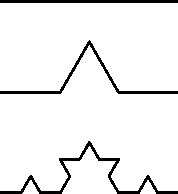 |
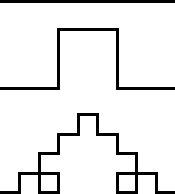
|
| Koch curve | Saxon curve |
Let me supplement this example with one more interesting fact. Mandelbrot, the
best-known researcher of fractal geometry, gave as the characteristic parameter
of fractals precisely that extent of fragmentation, which—as mentioned
above—can be expressed in broken numbers. According to Mandelbrot's definition,
the measure of “fractal dimension” can be calculated if we take the
logarithm of a broken number whose numerator is the number of steps required
for the particular degree of brokenness, whereas the denominator is the actual
size of the object. In Koch's curve, the length of the final curve is only three
units even after four steps (as one can see in the figure above), thus the fractal
dimension of the curve is the logarithm of 4/3, which is 1.2619. If we apply
the same procedure to “Saxon's curve,” we should observe that he achieved
a form of a three-unit volume through five steps, so the fractal dimension will
be the logarithm of 5/3, which is 1.4650. If we compare these two numbers, we
will realise that the “oscillation,” the brokenness of the Koch curve—though
overrides the simple world of one-dimensional lines, is nonetheless closer to
the line than the almost one-and-a-half dimensional laceration of the “Saxon
curve.” In other words, “Saxon's curve” comes closer to two-dimensional
figures, that is, it “hatches” better.
Since fractals bearing broken numbers as fractal dimension would only become
objects of physical reality if the actions leading to fragmented fractal forms—division
or fragmentation—could indeed be continued ad infinitum. Ideally, any fractal
form would take on infinite dimensions, through its fragmented, “porous”
structure it would increase to such an extent both in microscopic and macroscopic
realms that it would squeeze out everything else from the universe. This mental
act is, of course, a typically human generalisation, and does not reflect the
actual situation in nature, where fractal forms are bounded by the laws of the
material world. In reality, all those several million fractals can exist side
by side, or even penetrating each other, which, for example, any aerial photograph
will reveal in connection with ever so small patches of the earth. (This interpenetrating
fractal geometrical structure is, of course, invisible to the “naked eye.”
Nevertheless, M. F. Barnsley, the famous American mathematician has devised
a method with which satellite photographs showing an immense richness of detail
can be condensed into a few thousand fractal formulae—for easier storage.)
The fact that even seemingly accidental aerial photos can be turned into fractals,
that is, into absolutely regular and mathematically analysable shapes, proves
that the overwhelmingly beautiful fractal forms published in books (as well
as their relatives, Saxon-Szász's works) are highly “purified”
and idealised forms, and as such are no different than other human concepts
or cultural products brought forth by analytical thinking—the equally ideal
and pure shapes of Euclidean geometry, for instance. The importance of this
fact is not merely epistemological. As we are to prove later on, it is also
significant from the point of view of aesthetics.
In order to understand the significance of Saxon-Szász's works, let us
return once more to the history of fractal forms. As I have already mentioned,
it is surprising that although nature is full of fractal-like forms, we would
search in vain for such shapes in the past of human culture. Humanity, it seems,
has learned to think along the very lucid and simple lines of Euclidean geometry.
It appears that from all those few fractal motifs that have ever (accidentally?)
been produced by man, the oldest one is the mosaic ornament in the 12th-century
cathedral of Anagni, Italy. Namely, the decorative figures of that church are
constructed from elements which in fact are perfect fractals, and whose counterparts
were not produced before 1915, when the Polish mathematician Sierpinski created
his own similar forms (Anagni mosaic / Sierpinski's triangle).
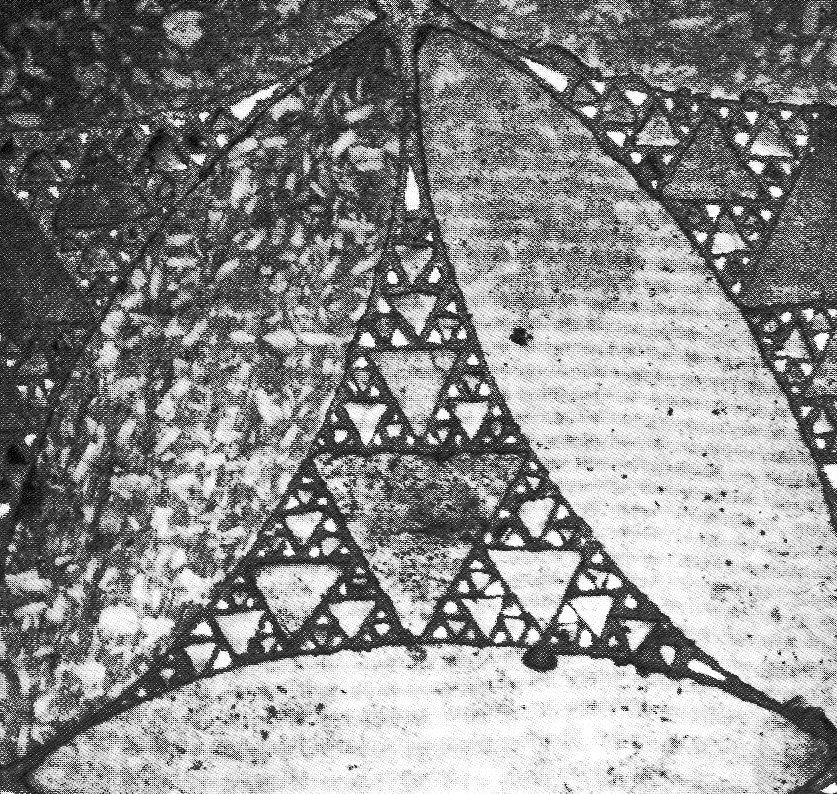 |
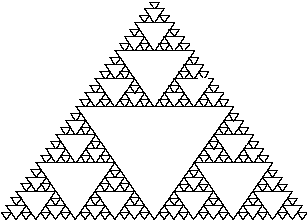
|
| Mosaique. Anagni, chatedrale | Sierpienski triangle |
For all his efforts, Mandelbrot, who was also keen on investigating the history
of mathematics, for which purpose he consulted a huge library of art historical
books and reproductions as well, could find but a handful of fractal-like images
from the fields of culture. Looking at Leonardo's drawings about the Flood,
or Hokusai's famous “Great Wave” woodcuts he thought he had found
motifs similar to fractals, repeating elements on smaller or greater scales—but
nowhere else. But mathematicians themselves had not come near fractal-like objects
before the 19th century. Hausdorff from Germany and Poincaré from France
researched mathematical sequences that have proved to show infinite fragmentation
or complexity and thus fall into the category of non-linear mathematics. Their
graphic representation results in fractals, too. Nevertheless, Poincaré
called these clumsy inventions “monsters,” mathematical beasts,since
they could not be treated with ease on the basis of either Euclidean geometry
or other mathematical methods known at the time (i.e. differential or integral
calculus). In his footsteps, however, and particularly in the years around 1900,
there emerged a number of people who found similar “monsters” and
created a series of mathematical and geometrical objects which can today be
considered fractals (mention must be made, among others, of Georg Cantor, H.
von Koch, Waclaw Sierpinski, or Giuseppe Peano and Gaston Julia).
In the end, however, it was only Mandelbrot who, in the 1970s, broke with the
notion that these formations should be treated as obscure, monstrous things.
For he had managed to develop a technique through which these infinitesimally
fragmented (almost dust-like) forms could be described, their parameters measured.
It was also him that first understood that the structuring logic of the natural
world rests precisely on fractal geometry, a formal system that is invariable
to scale-shifting. In the late-1970s and early 1980s he published his most important
books on this topic; however, his writings discussing this new chapter of mathematics
only became available in Hungary more than a decade later, and merely in a scattered
way.
*
All the more interesting is the fact that János Saxon-Szász, who
had been a high school pupil in Nyíregyháza in the 1970s, should,
quite independently of these developments, have shown interest in the special
forms of symmetry-changes, and the representation of scale-shifting in his very
first written work. Among other things, his “Universe” (1979), a drawing
he produced at the age of fifteen at the constructive summer symposium at Gönc
led by Tibor Csiky and János Fajó, documents this interest.

János Saxon-Szász : Universe (1979)
He remained a regular visitor at the Gönc summer school (later removed
to Encs) in the following years, and when he moved to Budapest in 1982, he carried
on his work at Pesti Mûhely (“Atelier Pest”), creating graphic,
plastic, and painted works, largely rooted in the spirituality of Constructivism.
He applied for admission to the College of Applied Arts in Budapest, but as
he was refused, he enrolled the Bánki Donát Technical College,
with the explicit purpose of acquiring technical knowledge that he would be
able to use in metal sculpture. And his composition “Structure” (oil
on canvas, 1988) demonstrates that even in his Constructivist works from this
period he investigated the scale-shifting of shapes.
In the nineties, he became a member of the international MADI movement led by
Arden Quin (MADI is an acronym of Movement, Abstraction, Dimension, and Invention),
whose free thinking and experimental attitude helped him understand, among other
things, what possibilities may emerge if a painting leaves the form of the rectangular
frame and takes on elements of other object-creation. It was through this that
he eventually arrived at the notion of the “shaped canvas,” of “shaped”
or formatted paintings.
As a mathematician, starting from Poincaré, Saxon-Szász might
in the end have rediscovered what Mandelbrot had established just a few years
before. In the event, however, due to the decisions he made after graduating
from the technical college, and the different artistic circles and schools he
was associated with, Saxon's artistic ambitions and innate mathematical gifts
helped him elaborate his own system of forms (so like fractal geometry), which
served as a basis for his creative activity and could be attached to geometric
abstraction, an important tradition in art, rather than a more sterile understanding
of mathematics.

János Saxon-Szász : Structure (1988)
Small wonder, then, that he elaborated his own terminology independent
of the international context of mathematical research, more related to, say,
the language of Constructivism. Among the differences the most important and
most characteristic one is the fact that Saxon-Szász consistently uses
the word “dimension” in the sense of “scale,” or “order
of magnitude,” and not in the way one uses it in connection with two-dimensional
planes or three-dimensional space. Thus when he mentions poly-dimensional fields,
these must be conceived of as working spaces where forms are repeated in smaller
and larger dimensions, and hence each and every motif is subordinated to the
gradated rhythm of scale-shifting (change of dimension), which pervades the
entire work. (No one should think of the preposterous idea of encountering science-fiction-like
four- or five-dimensional objects.)
Scale-shifts themselves, as well as the repetitious logic enabling them, are
known as “iterations” in mathematics (hence the expression “iterative
mathematics/geometry”). Since the early 1990s, Saxon-Szász has created
a series of pictures which are no longer experiments or speculative questionings;
any mathematician would see their connection to iterative geometry or fractals
at once. On the other hand it is equally sure that the selfsame works by Saxon-Szász
will nonetheless be considered products of the creative arts by any art critic—the
only thing added would be that fractal geometry has turned into ideograms in
these pictures, i.e. it takes on a symbolic role as it returns. Saxon-Szász
has succeeded in bringing together in perfect harmony two realms that lie far
from each other, namely mathematics and the communicative forms of creative
art.
In the nineties, his works started to arouse world-wide interest; he was invited
to exhibit and he also received scholarships. One of his most important experiences
proved to be the invitation of the Espace de l'Art Concrete in Mouans-Sartoux,
France. He not only had the opportunity to work in an atelier for five months,
but he was also commissioned to lead a creative circle where he had to put his
notions into words, and practice. As a result of this scholarship and the work
of these months the multilingual publication “Dimension Crayon” appeared,
supported by the Espace de l'Art Concrete and MADI. In this booklet Saxon-Szász
expounded his programme under the title of “Poly-Universe”—this
text can be considered both an artistic manifesto and a proclamation discussing
a peculiar variant of fractal geometry.

János Saxon-Szász : front page of the publication Dimension crayon
The fact that Saxon-Szász immediately writes about a kind of universe,
throws light on two elements which are utterly central in his entire oeuvre.
One of these may be derived from fractal geometry itself, since it follows from
the logic of infinite sequences and their features. For if iterative geometry,
in theory, works with sequences calculable ad infinitum, then—as already
mentioned—each model will, at least in principle, have infinite extension.
And this maximal principle may indeed give one the impression that a single
fractal is, at least in one's mind, a separate world, a complete universe in
which exclusive laws are at work.
The other characteristic is a consequence of these highly idealised circumstances:
if a model (a work of creative art, as it is in our case) can be taken for the
iconic representation of a possible world within its own logical system and
is like a thought-out universe, then the models (or pieces of art) thus arising
will become utopias, in the sense used by Thomas More himself: islands with
a symbolic meaning, standing opposed to the real world as its possible alternatives,
“better” variations.
There is a work in Saxon-Szász's oeuvre, which could be called his most
complex piece so far: his “Poly-Dimensional Chess,” which perfectly
illustrates this utopian island function. This three-dimensional object models
a chess board, whose fields become proportionately smaller as one proceeds further
and further away from the centre of the board. The decrease of their size follows
a constant scale-shift. This, of course, also means that each move in this universe
is synonymous with a change of the figures' size as well. In fact, if we accept
this board as a model of universal appeal, then the rhythm of scale-shifting
will also prevail over a great deal of other things in addition to the figures;
it will constrain all those objects or persons who come into contact with the
board—eventually even the players who sit down for a game. So the entire
world can be summoned to this chess board, while this separate universe extends
into infinity according to its own laws, and at the same time, for onlookers,
it becomes infinitesimally small only a few inches from the edge of the board:

JánosSaxon-Szász : Dimension chess
What is the moral of all this? Saxon-Szász has chosen the word universe
in order to imply that his pictures should really be taken for possible worlds,
models of universal validity, which brings him into the distinguished company
of avant-garde utopias. Let me merely refer to the origins of Malevich's oeuvre,
the Black Square, which Malevich intended as a model for a possible new cosmos;
and let me mention his Suprematist manifestoes, in which the system of similar
forms occurs as a de facto world model. I should also point out that, accordingly,
Malevich not only created graphic works and paintings, but also spatial forms,
Suprematist architecture—as though he had really wanted recreate the world.
Mondrian had similarly universal claims when he appeared with his specially
structured paintings within the Constructive tradition. And Le Corbusier went
as far as to hope to plan entire cities (or even more countries, or a whole
new globe) within his own utopian vision, whose model—and this is very
interesting!—he also furnished with a basic set of proportions; his “modulor”
was founded on a combination of the golden section as well as human proportions.
It is the icing on the cake that researchers investigating the more complex
forms of fractal geometry—fractals operating with so-called period doubling—discovered
a constant “modulor,” which can also serve as a model. This constant,
Feigenbaum's number (Mitchell Feigenbaum, d=4.669201…), whose importance
can only be compared to that of p, was dubbed the “universal constant”
by mathematicians, as it provides the key number to more complex objects, events,
structures and proportions in a way that is valid for the entire universe; this
key number defines which place the threshold of proportion where the change
or leap critical for the scale-shift occurs has in the sequence of numbers.
(It can be proved mathematically that scale-shifting is only possible in proportion
with “d” in Mandelbrot's set as well as in any other complex sequence
or fractal making use of involution and recursive arithmetical techniques. This
also means that the validity of “d” is as exclusive as that of p with
regard to a circle and its radius.) Although Feigenbaum's number only applies
to the physical world, we could say that sometimes it leads to such fantastic
human reactions and conclusions that these speculations no longer seem scientific
theories, rather the elements of general human culture. And this blurring of
borderlines works vice versa as well: the works of Saxon-Szász belong
to the world of creative art, and yet they are created in a way that in their
composition such proportions, or “modulors” play the central role
which are based on a strict scientific system. The fact that in spite of all
this Saxon-Szász has remained a creative artist, is due to the overwhelming
cultural function of his works. Even in his partial solutions one can easily
discover many elements that can only be explained in relation to the traditions
of painting.
One of the most intriguing formal elements which explain why his poly-dimensional
compositions never turn into mere illustrations in spite of their similarity
to fractals is the “co-planal” technique (“auxiliary planes”)
he uses. For when Saxon-Szász has iterated a geometric form and grouped
the emerging shapes, he may still not consider his work complete; he takes the
opportunity to provide a “background” to his composition by linking
the corner points and bridging the gaps (see the gray fields):

This procedure is an arbitrary move from the point of view of mathematics, but aesthetically speaking it is something extraordinary from the vantage point of the cultural background of these paintings, since this is how the work is turned into an icon, an image of symbolic meaning, and this is how it receives its rich symbolic aura that enables it to take on an additional sacred function. In Saxon-Szász's works this quasi-sacred element is a utopian meaning—it emphasises his aim that his works should define norms and laws and serve as symbolic models for possible worlds. Once again I must call upon Malevich and the iconic structure of Suprematist pictures as an analogy.

János Saxon-Szász : Polidimenzional black square
It very seldom happens that a geometric form capable of iteration should be
suitable as an icon on its own. If we find any, it is because it is formally
related to the genre of the icon. One example can be the square, as it has the
shape of the wooden board. On one occasion, Saxon-Szász did indeed take
Malevich's Black Square as his starting point, and gave his work the title “Poly-dimensional
Black Square.” The sides of this square are divided in a 1:5 proportion,
and this is the scale-shift that leads to the creation of the “fringes”
surrounding the central shape. Saxon applied this division to the picture three
times. The outline of the consequent lacerated form is related to the inner
borderlines which could be retrieved from the “Dimension Steps” mentioned
earlier on (Poly-dimensional Black Square).
(An aside: the fractal dimension of the outlines can be calculated here as well.
Here we have eleven steps for a change of 5 length units; the result is hence
log [11/5], that is, 1.4899.)
Browsing among Saxon's works, one finds a whole series of compositions which
are the result of the iteration of not one but at least two geometric forms.
These most often feature angular shapes and curves that are embedded in one
another, for the contrast of such forms is the sharpest, and this gives additional
visual richness to the images. Saxon-Szász calls such compositional schemes,
created from several basic elements “mixed forms,” as opposed to the
“pure forms” composed from just one starting shape (Mixed Forms).
Such complex iterations are known in mathematics as well. Nevertheless, Saxon-Szász
does not follow these mathematical types; he only moves closer to nature when
he uses “mixed forms,” because—as I have already mentioned—true
as it is that the formal treasury of our environment can be analysed into a
great number of fractals, still it is very rare that one should find among these
“pure forms” or “unifractals” that could directly be transferred
into fractal colour picture books. There are many random (that is, accidentally
encoded) elements in the codes of the shapes to be found in the real world.
Moreover, there are many natural forms which, if we try to disentangle them,
defy our attempts, and show that the logic of their structure can only be unravelled
by means of multiple decoding, the use of several combined sets of proportions.
To all that has so far been said we may add as a supplement that from time to
time Saxon-Szász also creates works whose mathematical background cannot
be interpreted according to fractal geometry, but these works also emerge from
his playing with different proportions. Such are certain form sequences that
retain the volume of the original shape, but gradually change the proportion
of width and length. In such a case a composition may stretch, as though it
complied with the sucking force of a “black hole” known from cosmology
and were endangered by transmutation into “singularity,” where every
object extends into a thread thinner than a rail, but extremely long. Although
such compositions, their shape being rather lengthy, hardly fit the pages of
a booklet like the present one, we have tried to bring in an example among the
reproductions, all the more so, because it is likely that the artist will continue
to follow his instincts and investigate the extremes of playfulness that this
kind of game with proportions may allow him.
So much, then, about the direct relationship between fractal geometry and Saxon-Szász's
art. These examples, however, have not taken us beyond the technicalities of
his art and never ventured into realms other than the mathematical background
for his works. But the artistic output of Saxon-Szász is a permanent
cultural achievement within the creative arts, and although what has been said
so far is necessary for us to find the right place for his art in a wider context,
that context cannot be complete without addressing questions of the more expanded
world of the creative arts.
*
Much mention has already been made of the importance of Constructivist traditions,
since the activity of Saxon-Szász is, after all, related to this chapter
of 20th-century art history. It is another question, however, how far this almost
hundred-year-old tradition can still be considered alive, and if it has any
currency, in what form or validity it can incorporate Saxon's highly individual
achievements.
The century-long history of Constructivism can be divided into several chapters,
but effectively it is only two, rather sharply opposing tendencies that have
struggled within it, taking turns in having the upper hand.
The first such tendency was explicitly moral in its content, and ideological
in its nature; that is, it emphasised a normative, almost religiously messianistic
programme. It denied the importance of the visible forms within the world, and
it focused on give expression to the spiritual world lying behind natural forms.
In keeping with this, it placed into the centre of art emblems reduced to simple
forms, and iconic symbols, making them serve moral and spiritual values. In
the very beginning, in the art of Malevich, this ideological content had already
become dominant, so much so that the geometrically organised, “technicistic”
formal language of Suprematist works could have appeared of secondary importance.
(These geometric forms did not really originate in the world of technology,
but in the ornamental elements of Russian folk art, as well as the reduced,
geometric formal language of orthodox icon painting.)
The other current stressed the importance of tasks within everyday practical
life and tried to make a reduced, geometric art serve these very tasks as well.
This concept found its clearest expression in the programme of the Bauhaus (among
others: Gropius, Moholy-Nagy, Marcell Bauer, etc.). But even within the group
of Russian Constructivists there was a fraction that took design and the solution
of practical tasks of everyday life as its main mission (let us mention Lissitzky
or Tatlin, and the example of Rodchenko's Constructivism, which “served
society”). Then, in turn, the Dutch De Stijl movement returned once more
to a puritan morality, to a quasi-religious programme (Mondrian being the arch-example),
although even within this group it sometimes happened that one or another artist
“tumbled,” and undertook missions of design or architectural tasks.
At certain times, these two opposing tendencies became intertwined, for it is
undeniable that even technical, that is, design-related branches were based
upon a type of messianistic devotion—obviously, their art serving practical
purposes could not be self-evident as yet. In fact, the superiority of technical
culture was a teaching which they followed with prophetic enthusiasm. In any
case, together the Constructivist strivings of the 1910s and 20s achieved the
creation of a very firm camp, and in the end it was their efforts from which
the mother tongue of 20th-century visual culture and form-giving crystallised.
Difficulties only arose in the third part of the 20th century, as both the faith
in the redeeming power of Constructivist forms, and the missionary zeal of the
strictly geometric and functional design-school were misplaced—for no other
reason than the fact that the century not only used the achievements of Constructivist
tendencies, but also abused them, and in a few decades it devoured them, turning
them into commercial goods. From the 1960s onwards, neither the messianistic
enthusiasm, nor the more sober programmes of the Bauhaus were needed, since
even without them, everything was dressed in “modern” clothes. In
such a setting, only the presentation of overflowing abundance and flamboyant
playfulness could lead to some success, and indeed it happened so that the schools
of Neo-Constructivism (thus Vasarely's Op-Art, or Mobile Art, connecting illusionist
games with various sensations of movement) and all their “relatives”
set off from these effects. And even those who still believed in the ethical
superiority and moral power of Constructivism could only stay alive if they
kept pace with these new tendencies, and they concentrated their art around
movement, and change recorded in serial motif sequences; or the passing of time,
and the changing of forms in a playful hubbub; or again Constructivism dissolved
in a kind of action art. (This development can be traced in the Hungarian art
of the last decades of the 20th century as well: Gáyor, Maurer, Mengyán,
Halász, El Haszán, Csörgõ, etc., formed a series of
artists, which eventually “led the way out” from Constructivism.)
This situation—if we put it roughly—also means that among the circumstances
of the Post-Modern era one no longer needed Constructivism, an art form with
a mission, or an avant-garde tendency in the real sense of the word, undertaking
to give a total explanation for life. And at this point Saxon-Szász came
forth with his works of archaic terseness, subdued and scarce colours, and,
as regards formal elements, equally modest proportions!
No illusionism, but plenty of connections to a scientific world view; a search
for “better,” “more perfect,” and “more complex”
formal systems—these were Saxon's currency. These virtues resemble the
maxims of old, early Constructivism. In fact, even what innovation it offers
as opposed to the old, static Constructivism, namely, a more dynamic approach,
derives directly from its scientific attitude, and as such it also points back
to the mentality of classic Constructivism. An important difference, however:
Saxon's utopian system no longer stems from the technical culture of the early
20th century; contemporary mathematical theories, notably the world of fractals,
form its foundations. These theories, like his artistic approach, are searching
for an equilibrium on the border of chaos and harmony. This, of course, is the
fruit of a new appreciation of values, which is related to the new view of complex
systems, and which has few counterparts in the art of the present.
All this may lead one to believe that Saxon-Szász attempts to replace
the normative approach of classic Constructivism with more complex and indirect
utopias of the present day. His works are iconic, but not iconically static
or rigid; they stimulate one to move, to change, to think over one or another
motif. Instead of creating static ideograms, he creates images that start processes
whose logic leads one on towards infinity. This infinity, however, is not a
sensation of science-fiction films, but a world of transcendental values. As
opposed to those who looked for new sensualism or (not even so new) visual eclecticism
in fractal imagery, he is interested in the presence and maximalising power
of laws, and this is where the uncompromising mathematical strictness of his
pictures derives from. Through this, Saxon-Szász has revived a main characteristic
of the classic avant-garde, that is, the infinite purification of forms, or
reductionism. In the end, however, it is not mathematical terseness that lies
behind this symbolic language. He only uses his scientific world view as an
analogy, a metaphor, in order to communicate more general things, human values
through them.
What Saxon-Szász considers a value is—in all probability—that
form of self-limitation, which searches for its own values first and foremost
in the fields of intellectual experience and high mental demands. If we slightly
raise our horizons from the mathematical material used here, we will find that
the images themselves are also emblems for this more demanding basic attitude.
Through them, Saxon-Szász emphasises an approach, which contradicts both
the irresponsible wastes of consumer society and the illusionism and sensualism
of the ensuing information society. He considers these realms as labyrinths
or dead ends, and he works on a cosmos whose set of values is far more puritan
and ascetic. All in all, it is this very mission the hardly accessible mathematical
background of his pictures also reinforces, since it teaches one the lesson
that it is impossible to come near real values through cheap devices—who
wants to possess his art intellectually and to enter the world these pictures
merely symbolise must first undergo suffering.
These thoughts and demands could, of course, be little more than commonplaces,
if they were generally established in our time. But they are not so. The fact
that they can still be deciphered from Saxon-Szász's pictures proves
his extraordinary gifts. Only one argument could be brought up against him,
namely the fact that he stands on his own with his achievement—in this
way the use of the word “utopia” is not only justified from a poetic
or philosophical point of view, but also in a social and communicative respect.
János Saxon-Szász is living on an island he has created himself,
and this tiny patch of land is surrounded by the media world of mass society.
Saxon's solitude can on the one hand explained by the momentary situation of
universal culture, since it is connected to the fact that after the decline
of the avant-garde, universal art has entered an ebbing, what is more, problematic
epoch, and it may soon sink altogether in the ocean of mass arts. But on the
other hand it is also related to the fact that Saxon-Szász is living
in Eastern Central Europe, and this region has not yet made it to the “Land
of Promise,” to the wasteful richness of developed industrial societies,
which is a powerful factor in the minds of many. Here it is still possible that
someone should take as a role model the moral devotion of the classic avant-garde
and find new meaning for this ethical perfectionism. This is the reason why
the ascetic demand and perfectionism beaming forth from the paintings of Saxon-Szász
seems so special and exceptional.
It would be premature to draw the balance and refer to positive or negative
outcomes at this very moment. Since we do not see into the future, we do not
know the chances lying there either. Saxon-Szász is young, he has plenty
of time. It will be a long time before the epoch that he himself has been a
part of can be evaluated, and one can tell which tendencies came out victorious
from it.
Bibliography
Barnsley, Michael F. (1993). Fractals Everywhere. Second, enlarged edition.
Academic Press.
Behr, Reinhardt (1989). Ein Weg zur fraktalen Geometrie. Ernst Klett Schulbuchverlag.
Cramer, Friedrich (1989). Chaos und Ordnung: Die komplexe Struktur des Lebendigen.
Stuttgart: Deutsche Verlags-Anstalt.
Fokász, Nikosz (1999). Káosz és fraktálok: Bevezetés
a kaotikus dinamikus rendszerek matematikájába – szociológusoknak.
[Chaos and Fractals: Introduction to the Mathematics of Chaotic Dynamic Systems—for
Sociologists.] Budapest: Új Mandátum Könyvkiadó.
Fokász, Nikosz (ed.) (1997). Rend és káosz: Fraktálok
és káoszelmélet a társadalomkutatásban. [Order
and Chaos: Fractals and Chaos Theory in Social Research.] Budapest: Replika
Kör.
Gleick, James (2000). Káosz: Egy új tudomány születése.
[Chaos: The Birth of a New Science.] Budapest, Göncöl Kiadó.
Hermann, Dietmar (1994). Algorithmen für Chaos und Fraktale. Bonn–Paris–Reading,
Mass.: Addison-Wesley.
Mandelbrot, Benoit (1982). The Fractal Geometry of Nature. New York: W. H. Freeman
and Co.
Peitgen, Heinz-Otto & Dietmar Saupe (1988). The Science of Fractal Images. New
York–Berlin–Heidelberg: Springer-Verlag.
Peitgen, Heinz-Otto & Peter H. Richter (1986). The Beauty of Fractals: Images
of Complex Dynamic Systems. Berlin–Heidelberg–New York–Tokyo:
Springer-Verlag.
Perneczky, Géza (1998). Fraktálok és eseményminták.
[Fractals and Event Patterns.] Budapest: Kijárat Kiadó, Teve sorozat.
Prusenkiewicz, Przemyslaw & Aristid Lindenmayer (1990). The Algorithmic Beauty
of Plants. New York, etc.: Springer-Verlag. (These are the fractal representations
which Saxon-Szász's works approximate most closely.)
List of pictures / Képjegyzék
(page):
22 Universe / Univerzum 1979–80,
ink and serigraphy, 50x50 cm
29 Dimension Chess / Dimenziósakk
1998, oil on wood, 152x152x120 cm
49 Structure / Struktúra
1984–88, oil on canvas, 100x160 cm
50 Oscillo-circle / Rezgõkör
1989, oil on canvas, 90x100 cm
51 Ideon Threads / Ideonfonalak
1991, oil on canvas, 90x110 cm
52 Fight / Harc 1993, oil on
wood, 100x100 cm
53 Micro-Macro Energy Levels
/ Mikro-Makro energiaszintek 1993, oil on wood,
100x130 cm
54 Condensation / Sûrítés
1992, acryl on wood, 55x100 cm
55 Dimension Gates / Dimenziókapuk
1994, oil on wood, 60x140 cm
56 Space / Ûr 1992, acryl
on wood, 43x100 cm
57 Dimension Keys / Dimenzióbillentyûk
1994, oil on wood, 62x96 cm
58–59 Meditative Structures
I, II / Meditatív struktúrák I., II. 1995, oil on wood,
120x120 cm
60 Planar Eclipse / Síkfogyatkozás
1988–96, oil on wood, 100x100 cm
61 Dimension Steps / Dimenziólépcsõk
1996, oil on wood, 100x100 cm
62 Cosmic Oscillations / Kozmikus
rezgések 1996, oil on wood, 71x200 cm
63 Dimension Condensation I,
II / Dimenziósûrítés I., II. 1996, oil on wood, 28x200
cm,
41x200 cm
64 Yes-No / Igen-Nem 1997, oil
on wood, 60x100 cm
65 Immaterial Transit / Immateriális
átjárás 1997, oil on wood, 152x152 cm
66–67 Poly-dimensional Field
/ Polidimenzionális Mezõ 1998, oil on wood, 350x190x5 cm
68–69 Dimension Aerials
I, II / Dimenzióantennák I. II. 1999, oil on wood, 26x200 cm,
| 37x200 cm |